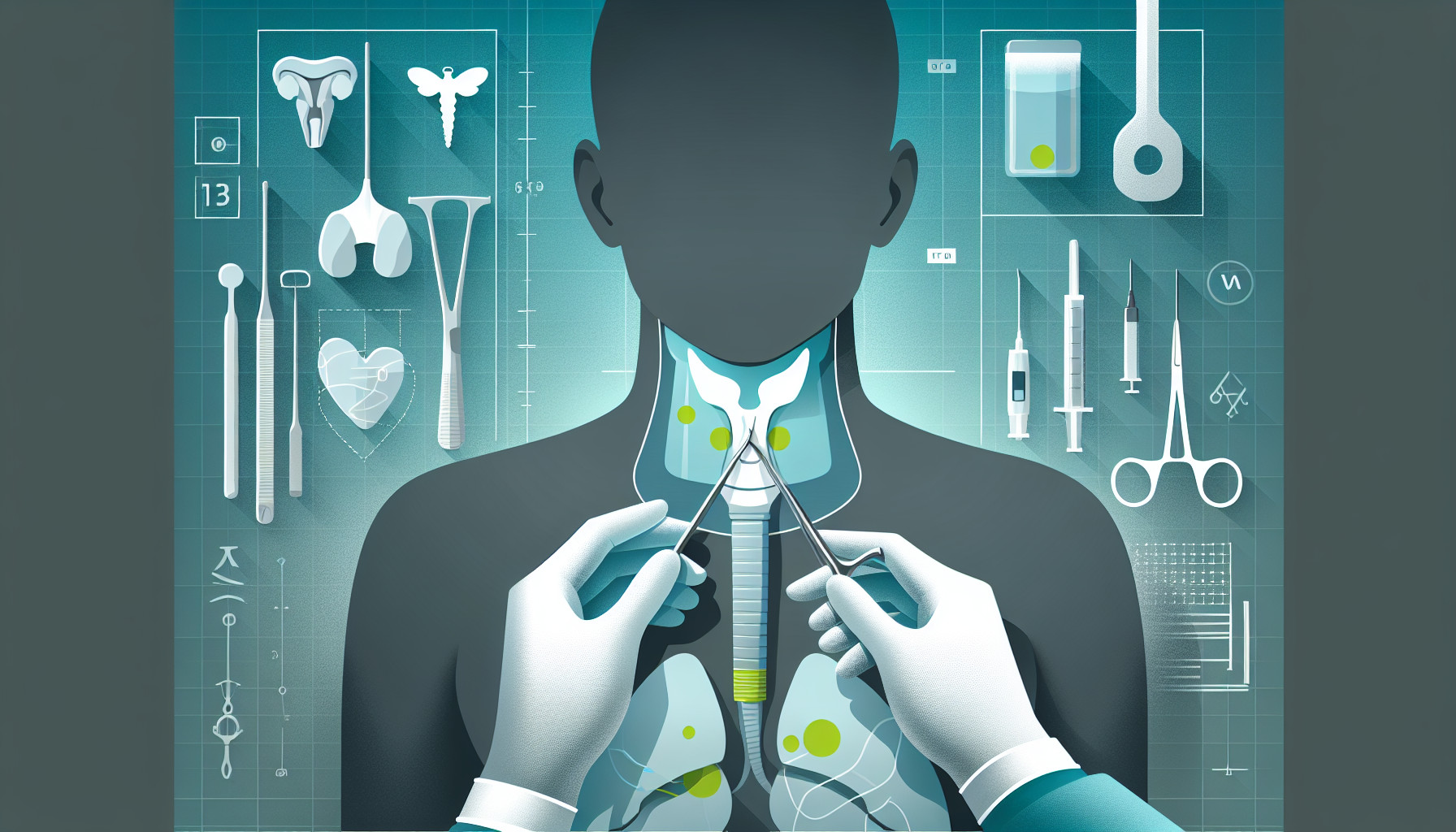Our Summary
This research paper discusses a different method of performing thyroid surgery to avoid leaving a scar on the neck. The method is called the endoscopic bilateral axillo-breast approach (BABA), and it involves making incisions in the armpit and around the nipple. This paper presents the results from the first 15 surgeries using this approach, which were performed between June 2017 and June 2018.
The results show that on average, the surgeries took around 4 to 5 hours, and patients stayed in the hospital for about 1-2 days. About 37% of the patients experienced a temporary decrease in parathyroid function, but none had permanent loss. One patient had temporary nerve damage. Around 80% of the patients experienced some numbness or tingling in the chest area after the surgery, but this was mild and went away within a month. Overall, patients were very happy with the cosmetic results of the surgery.
The researchers conclude that while this method of surgery requires a surgeon with a lot of experience in endocrine and endoscopic surgery, it is a good option for patients who are particularly worried about scarring on their neck. They suggest that more research should be done to determine when this method should be used.
FAQs
- What is the endoscopic bilateral axillo-breast approach (BABA) for thyroid surgery?
- What were the results and complications from the first 15 surgeries using the BABA method?
- Who is a suitable candidate for the endoscopic bilateral axillo-breast approach (BABA) for thyroid surgery?
Doctor’s Tip
A helpful tip a doctor might tell a patient about thyroidectomy is to make sure to follow all post-operative care instructions provided by the surgeon. This may include taking prescribed medications, monitoring for signs of infection, and attending follow-up appointments. It is also important to communicate any concerns or changes in symptoms to the medical team. Additionally, maintaining a healthy diet and lifestyle can help support recovery and overall thyroid function.
Suitable For
Patients who are typically recommended thyroidectomy include:
Patients with thyroid cancer: Thyroidectomy may be recommended for patients with thyroid cancer to remove the cancerous tissue and prevent it from spreading to other parts of the body.
Patients with large thyroid nodules: Thyroidectomy may be recommended for patients with large thyroid nodules that are causing symptoms such as difficulty swallowing or breathing.
Patients with hyperthyroidism: Thyroidectomy may be recommended for patients with hyperthyroidism (overactive thyroid) who have not responded to other treatments such as medication or radioactive iodine therapy.
Patients with thyroid nodules that are suspicious for cancer: Thyroidectomy may be recommended for patients with thyroid nodules that are suspicious for cancer based on imaging studies or biopsy results.
Patients with recurrent thyroid nodules: Thyroidectomy may be recommended for patients with recurrent thyroid nodules that continue to grow or cause symptoms despite previous treatments.
Patients with a family history of thyroid cancer: Thyroidectomy may be recommended for patients with a family history of thyroid cancer, especially if they have a genetic predisposition to developing the disease.
Patients with Graves’ disease: Thyroidectomy may be recommended for patients with Graves’ disease (an autoimmune condition that causes hyperthyroidism) who cannot tolerate or do not respond to other treatments.
Patients with compressive symptoms: Thyroidectomy may be recommended for patients with compressive symptoms such as difficulty swallowing, breathing, or speaking due to an enlarged thyroid gland.
Timeline
Before thyroidectomy:
- Patient consults with endocrinologist or surgeon to discuss symptoms and treatment options.
- Patient undergoes various tests including blood tests, ultrasound, and fine needle aspiration biopsy to confirm diagnosis.
- Patient discusses surgery with surgeon and prepares for the procedure by following pre-operative instructions.
- Patient undergoes thyroidectomy surgery, which typically takes 2-4 hours under general anesthesia.
- Patient stays in the hospital for 1-2 days for monitoring and recovery.
After thyroidectomy:
- Patient experiences some pain and discomfort in the neck area, which can be managed with pain medication.
- Patient may have temporary difficulty swallowing or speaking due to swelling in the throat.
- Patient may experience temporary changes in hormone levels, which can be managed with medication.
- Patient may have a scar on the neck from the incision, which typically fades over time.
- Patient follows up with surgeon for post-operative care and monitoring of thyroid hormone levels.
- Patient may need to take thyroid hormone replacement medication for the rest of their life to maintain proper hormone levels.
What to Ask Your Doctor
- What are the potential risks and complications associated with the endoscopic bilateral axillo-breast approach (BABA) thyroidectomy compared to traditional thyroidectomy?
- How experienced are you in performing the BABA thyroidectomy procedure?
- How long is the recovery time expected to be after undergoing a BABA thyroidectomy?
- Will I need to take any special precautions or follow a specific post-operative care plan after the BABA thyroidectomy?
- What will the scar look like after the BABA thyroidectomy, and how can I expect it to heal over time?
- Are there any specific criteria that make me a good candidate for the BABA thyroidectomy procedure?
- How does the cost of the BABA thyroidectomy compare to traditional thyroidectomy?
- What are the long-term implications of undergoing a BABA thyroidectomy, if any?
- Are there any alternative treatment options to consider besides the BABA thyroidectomy?
- Can you provide me with any additional resources or information about the BABA thyroidectomy procedure to help me make an informed decision?
Reference
Authors: Mercader Cidoncha E, Amunategui Prats I, Escat Cortés JL, Grao Torrente I, Suh H. Journal: Cir Esp (Engl Ed). 2019 Feb;97(2):81-88. doi: 10.1016/j.ciresp.2018.11.006. Epub 2019 Jan 26. PMID: 30691690
